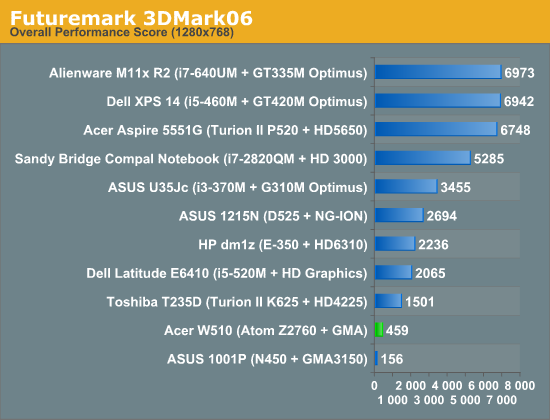The Clover Trail (Atom Z2760) Review: Acer's W510 Tested
by Anand Lal Shimpi on December 20, 2012 10:34 AM ESTGPU Performance
Contrary to popular opinion prior to its launch, the Clover Trail platform and Cloverview SoC feature a PowerVR SGX 545 GPU. The rumored PowerVR SGX 544MP2 won’t show up until Clover Trail+ next year. The SGX 545 is clocked at a fairly aggressive 533MHz.
Architecturally the 545 is very similar to the PowerVR SGX 540 used in Intel’s Medfield smartphone platform, with a handful of additions. The shader array remains unchanged at four USSE pipes. The 545 adds four more 10-bit integer pipes, doubles the triangle setup rate and doubles the number of depth test units as well. DirectX 10 class texture hardware is also a part of the mix, as well as everything else needed to officially support DirectX 10 (D3D feature level 9_3).
Compared to what’s shipping in the latest iPads however, Clover Trail is horribly under-specced. We don’t have good cross-platform (Windows RT/8) GPU tests yet, but based on what I’ve seen thus far it looks like the GPU here is a bit slower than what you get in a Tegra 3.
| Mobile SoC GPU Comparison | |||||||||||
| PowerVR SGX 545 | NVIDIA Tegra 3 | PowerVR SGX 543MP2 | PowerVR SGX 543MP4 | PowerVR SGX 554MP4 | |||||||
| Used In | Clover Trail | Tegra 3 | iPad 2/mini | iPad 3 | iPad 4 | ||||||
| SIMD Name | USSE | "core" | USSE2 | USSE2 | USSE2 | ||||||
| # of SIMDs | 4 | 12 | 8 | 16 | 32 | ||||||
| MADs per SIMD | 2 | 1 | 4 | 4 | 4 | ||||||
| Total MADs | 8 | 12 | 32 | 64 | 128 | ||||||
| GFLOPS @ 300MHz | 4.8 GFLOPS | 7.2 GFLOPS | 19.2 GFLOPS | 38.4 GFLOPS | 76.8 GFLOPS | ||||||
Looking at raw FP performance tells us a lot of the story. The 545’s high clock helps it punch above its weight, but it's still significantly less powerful than the 543MP2 used in the iPad 2/mini (and it’s nothing compared to what’s in the iPad 3/4).
Tegra 3-class GPU performance may have been acceptable a year ago running Android, but it’s just too little too late today. Since Clover Trail has full backwards compatibility with older Windows applications, I can put its GPU performance in perspective. Turning to 3DMark03 and 06, we can get a good idea of the class of performance we’re looking at. For complete (and consistent) comparison points, I've tossed the W510's results into Bench so you can compare to any notebook/mobile GPU you want to there.


Compared to the old Atom platform with Intel’s GMA 3150, the PowerVR SGX 545 based GMA is around 3x faster. Even Intel's old mobile G45 graphics are actually slightly slower. Performance is still far behind everything else modern though. The GPU is more than adequate for Modern UI acceleration, but if you have secret hopes of being able to run some of your older games on Clover Trail you’ll want to stash those dreams away.
None of this is really Imagination’s fault - Intel remains generations behind in implementing competitive GPUs in its ultra mobile SoCs. Even the jump to PowerVR SGX 544MP2 next year will happen just as Apple likely moves to Img’s Series 6 (Rogue) architecture. It’s definitely a problem if you’re a silicon company that delivers slower silicon than what your customers can put together.










104 Comments
View All Comments
DaveSimmons - Thursday, December 20, 2012 - link
If you get a chance could you test the Netflix performance, both on the screen and through the HDMI?fredbloggs73 - Thursday, December 20, 2012 - link
I would also like to know how this tablet performs with an external monitor in a desktop environment. I get the feeling that the GPU will limit this function.unrulycow - Thursday, December 20, 2012 - link
The table on the first page should be changed to reflect the fact that the Nexus 10 starts at $399, not $499Anand Lal Shimpi - Thursday, December 20, 2012 - link
Fixed!kyuu - Thursday, December 20, 2012 - link
Yeah, that's about what I was worried about with Haswell -- marginally better CPU performance than the Atom we know and hate, and an utter crap GPU. Thanks but no thanks, Intel. If they stuck Brazos in these devices they'd be way more appealing (assuming a similar power-profile).I'm very interested in getting one of these devices, but Haswell is a no-go, and I'm not sure about something like the Surface Pro. Its specs are great (asides from Intel's crap GPU, again, but at least the HD4000 is passable), but I'm thinking it's going to be too heavy/bulky, too warm, and too noisy (fans) to be something I'd take over a regular laptop.
Hopefully the 2nd gen devices come sooner rather than later, as these 1st gens just aren't cutting it.
kyuu - Thursday, December 20, 2012 - link
Oh, and uh... I remember a review of the Lumia 920 being in the works, like, weeks ago. Did that get shelved or what's going on with that?name99 - Thursday, December 20, 2012 - link
Oh don't be an idiot.The numbers are basically that a high-end Atom is about 1.5x the CPU performance (on multithreaded tasks only? not clear from what Anand has given us here) of a high end ARM.
Meanwhile a high-end IB i7 is 5x the performance of a high-end ARM, and Haswell will improve on that.
Haswell is a high performance followup to IB, it's not a followup to Atom.
kyuu - Thursday, December 20, 2012 - link
Sorry, I am an idiot: I meant Clover Trail, the SoC in this tablet, not Haswell. That was an utter brain fail on my part. ><Ytterbium - Thursday, December 20, 2012 - link
Hi Anandtech,Can you review the Dell Latitude 10 & Lenovo ThinkPad Tablet 2?
I think each one has some unique features vs the ones you looked at so far.
jeffkibuule - Thursday, December 20, 2012 - link
I don't think the editors have enough time to review every single laptop/tablet released. Besides, is the Lenovo ThinkPad Tablet 2 even out yet?